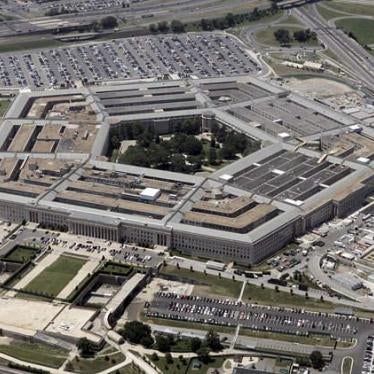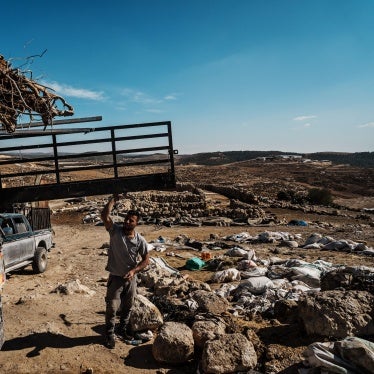Statement of Human Rights Watch on “‘Targeted Killing’ and the Rule of Law: The Legal and Human Costs of 20 Years of U.S. Drone Strikes" before the Senate Judiciary Committee on February 9, 2022.
Human Rights Watch thanks the Senate Judiciary Committee for the opportunity to submit this statement for the record for its hearing “‘Targeted Killing’ and the Rule of Law: The Legal and Human Costs of 20 Years of U.S. Drone Strikes.” Portions of the statement have been adapted from various materials published by Human Rights Watch staff members regarding civilian harm.
Human Rights Watch investigates and reports on violations of international human rights and international humanitarian law by states and non-state armed groups in about 100 countries around the world. Our staff is comprised of about 450 people from more than 70 nationalities who are country experts, lawyers, journalists, and others who work to protect those most at risk, including civilians in wartime.
Alongside other nongovernmental organizations, Human Rights Watch has been documenting civilian harm and other abuses by US military forces and the Central Intelligence Agency (CIA) for more than three decades. Notably, abuses by the US military and CIA go far beyond drone strikes, which are the scope of this hearing. We have called on the US, for instance, to avoid the use of explosive weapons with wide-area effects in populated areas. This statement focuses primarily on drone strikes conducted by the US military. Covert strikes carried out under Title 50 of the US Code are an additional issue that Congress should address, as their very nature makes them beyond the reach of the democratic oversight including by the people of the United States.
In November, US Secretary of Defense Lloyd Austin said the US military “must work harder” to reduce civilian casualties. While Human Rights Watch is cautiously optimistic about recent commitments by Secretary Austin to address civilian harm, we have seen expressed commitments like these for years with little real change on the battlefield or in policy. The US military needs to finally address systemic flaws—problems the Defense Department itself has acknowledged in internal reviews—and allow an independent review of the civilian harm caused by its operations.
Congress should step in and urgently exercise oversight; this hearing is an important step forward.
Protecting Civilians from Unlawful Harm
Under international humanitarian law, or the laws of war, governments are legally obligated to protect civilians from harm during armed conflict. Avoiding even legally permissible civilian harm should be the goal of policymakers and armed forces. Even strikes that take every precaution to avoid killing civilians can result in lost lives, lifelong injuries, and damage to homes and vital infrastructure such as roads, bridges, and power and water supplies. The US military says it abides by the laws of war by taking all feasible precautions to limit these harms. However, its actual record shows a pattern of dubious adherence to the rules and repeated mistakes that are violations of the laws of war, and evidence of recklessness and even deliberate violations that amount to war crimes. Even if every single civilian death caused by US strikes was considered legal under the laws of war, the sheer number of them and the similarities between them would be major cause for concern.
Flaws in US Operations Lead to Civilian Deaths, Injuries, and Other Harm
The August 2021 strike in Kabul was a tragic, recent example of the sorts of flaws that lead to avoidable civilian deaths—flaws well known to anyone who has been paying attention to civilian casualties over the last two decades. In the Kabul case, US drone operators tracked a man named Zemari Ahmadi for eight hours, convinced that he was a terrorist. Days earlier, the Islamic State affiliate in Afghanistan, known as ISIS-K, carried out a bomb attack at the Kabul airport, killing an estimated 170 Afghan civilians and 13 US service members. The US military was under pressure to prevent further attacks. After conducting hours of surveillance, the US military killed Ahmadi and nine others nearby with a Hellfire missile. But the media reported that Ahmadi was an employee of a US-based humanitarian aid group who was going about his ordinary business, and the other nine people were also civilians, seven of them children.
In the wake of the Kabul attack, the Pentagon did what it nearly always does when the media calls it out for killing civilians. First it denied that civilians were killed, insisting that the strike was “righteous” and the target legitimate—a suspected ISIS suicide bomber. Then, days later, in the face of conclusive evidence of civilian casualties, it called the strike a “mistake” and began a classified investigation. Finally, as has been the result of nearly every civilian casualty investigation for the last 20 years, the Pentagon found no officials or service members at fault and announced that no one would be held accountable.
Lt. Gen. Sami Said, the inspector general of the US Air Force, called the Kabul strike “unique” because of the conditions on the ground in August. It is true that Kabul was particularly tense after the ISIS-K airport bombing, but there is nothing unique about an edgy environment in theaters of war. What occurred is what US drone operators have done so many times in the last two decades. They allowed themselves to be misled by what’s known as confirmation bias—the tendency to interpret information in a way that confirms one’s prior beliefs. Fearing another attack by ISIS-K, they mistook water bottles in Ahmadi’s car for explosives and Ahmadi for a suicide bomber. The operators were thinking more about the threat and less about the available evidence contradicting the conclusion that Ahmadi was one—for example, the fact that he had visited the office of his California-based humanitarian organization earlier that day.
It would be problematic enough if this were an aberration. It isn’t. Human Rights Watch has documented at least 27 incidents in which US-led coalition forces against ISIS in Iraq and Syria killed civilians in apparently unlawful attacks. Using explosive weapons in populated areas, these attacks hit homes, mosques, a market, a hospital, and a school, among other civilian objects.
Human Rights Watch has also repeatedly documented US drone strikes causing civilian casualties elsewhere, including one on a wedding procession and another on a respected cleric and policeman in Yemen, and clearly unlawful strikes on a Doctors Without Borders’ hospital in Afghanistan and on a minibus in Somalia. In the case of targeted killings in Yemen before the 2015 armed conflict, it is not clear whether the strikes were carried out by the US military or by the CIA, where the opacity over targeted killings was even more problematic, compounding the challenges in ending the accountability vacuum for attacks gone wrong.
Larry Lewis, a scientist who has led or participated in every official US study on civilian harm, conservatively estimates there’s been at least one civilian casualty incident per week from US attacks since the 9/11 attacks in 2001. Nobody knows how many deaths these incidents caused; the US government doesn’t even know. What is known is that many civilians were needlessly killed.
Confirmation bias isn’t the only problem plaguing the system. Like many civilians killed by the US military, Ahmadi had been misidentified as a legitimate target. That is, he was not the victim of a strike intended to kill someone else. The positive identification of valid military targets is one of the most critical functions of airstrike teams since it leads to decisions about who lives and who dies. Yet such teams have misidentified civilians as legitimate targets in case after case after case. For example, a 2013 report by Lewis described how the majority of civilian casualties caused by US military actions from 2007 to 2012 were the result of misidentification. A 2018 Pentagon study by experts including Sarah (Holewinski) Yager, then senior advisor on human rights in the Chairman’s Office at the Joint Staff of the US Defense Department and currently the Washington Director of Human Rights Watch, also contained significant evidence that civilians were misidentified as lawful targets and killed in the 2016 US military campaign to retake Mosul in Iraq from ISIS and again during the effort to rout ISIS from Raqqa in Syria in 2017.
Another documented flaw in US military operations is that drone strikes repeatedly miss the presence of civilian bystanders, including in the recent Kabul strike in Afghanistan. Drone operators tend to zoom in when conducting surveillance on a possible target. Although this makes it easier to see the suspect, it also makes it more difficult to see what could be around that target, including civilians coming and going. Strike teams can mitigate this risk by zooming out to look for civilians before launching an attack, in line with the laws-of-war requirement to take all feasible precautions to protect civilians. The team that carried out the strike in Kabul last August apparently did not do that, judging from a Defense Department fact sheet and comments from officials. Seven children just outside the frame were killed.
Poor communication during an operation can also lead to civilian deaths. That’s because within a drone operation there is often a ground team, a higher command team based elsewhere, an imagery team often based in the United States, and a separate team taking the strike. They’re not necessarily all speaking to each other. So, an imagery analyst trying to discern whether a person is male or female might relay their finding to the command center, but the command center may not share the finding with the trigger-puller or may misinterpret the finding when passing it on. There are ways to make this function better, but the US military has not done them. Said, the inspector general who conducted the Kabul strike investigation, indicated that members of the strike cell did not alert others on the team that they were about to launch the attack. The CIA also had eyes on the target in the Kabul strike and saw the children nearby but was not able to get the information to the drone operators in time. The reason why has not been made public.
The most common pattern in US airstrikes is how rarely anyone is held responsible for unlawful civilian deaths. Repeated internal investigations have resulted in little punishment, even disciplinary action, perhaps in part because units are investigating themselves. In the dozens of cases documented by Human Rights Watch in which US military strikes resulted in unlawful civilian casualties, to the best of our knowledge, there has only been one instance where individuals have been held accountable – and even in that situation, discipline fell short of a criminal inquiry. If military personnel and civilian officials knew they might lose their jobs on account of negligence that led to civilian deaths, they would take greater care to avoid future mistakes.
The US military should also reform its justice system to ensure its independence from the chain of command—and criminal liability should be on the table for those who negligently or intentionally kill civilians. These and other consequences should be brought to bear in the military coverup of some 70 civilian casualties recently uncovered by a New York Times investigation of a 2019 airstrike in Baghuz, Syria, carried out by the classified special operations unit, known as Task Force 9. The Pentagon is conducting an internal investigation of this incident, but it is magical thinking to expect any accountability.
Pressure to Reform is Needed from Top Down
US forces have shown progress is possible when there is pressure from the top to improve. Military commanders and civilian defense leaders have grappled with these problems and have found solutions that save lives. When leadership makes protecting civilians a priority, subordinates take it seriously.
In 2005, US commanders in Iraq realized their forces were killing civilians at checkpoints at alarmingly high levels and brought the problem under control within a year. In 2009, Gen. Stanley McChrystal, the commander of international forces in Afghanistan, made changes to military tactics that led to a 28 percent drop in civilian casualties. Similarly, the average number of civilians killed in errant airstrikes in Afghanistan dropped more than 40 percent after a 2010 tactical directive, a document that provides guidance for troops on the ground, instructed that keeping civilians alive during US military operations was a priority. In 2011, Lewis convinced the US command in Afghanistan to analyze strike data and civilian harm to see if it could lower the risk to civilians. After doing the analysis, he sent the then-commander, Gen. David Petraeus, some suggestions on how to improve, which Petraeus implemented. Civilian deaths started to go back down.
But these changes didn’t last. Over time, the solutions one commander found useful—not just for saving lives but also for maintaining local support for US military efforts—were eschewed by his replacement. Guidance that once saved civilian lives was loosened to make way for some other priority. As this played out, the military forgot what it learned, or worse, did not care enough to make improvements last. For example, in 2009, Admiral Michael Mullen created and led the Joint Staff civilian casualty working group, putting a much-needed spotlight on ways to reduce civilian deaths in Afghanistan. But after some progress, the Pentagon disbanded the group and any improvements were lost.
The same cycle of learning and forgetting happened in the White House, too. Protection rules issued by President Barack Obama, requiring “near-certainty” that civilians were not present or would not be harmed by targeted strikes, were an important step forward even though they apparently were not always followed as Human Rights Watch found in Yemen. Yet they were promptly undone by his successor, President Donald Trump. Even before taking office, Trump set the tone on this issue by giving elements of the US military the leeway they wanted to not be so careful about civilian harm. His first secretary of defense, Gen. (ret.) James Mattis, told a meeting of US counterterrorism partners that the president directed the US military to “annihilate ISIS.” It’s hard to believe that such rhetoric didn’t pave the way for the military to care less about the civilian population on the battlefield.
Conclusion: Further Congressional Oversight Needed
While Human Rights Watch is cautiously optimistic about Secretary Austin’s recent pledges to reduce civilian harm, the Pentagon and the White House, over multiple administrations, have shown they cannot—or will not—fix these problems with solutions that stick. The only viable option is to look to Congress for leadership and accountability. But before members of Congress can solve the problems, they need to understand them. They can start by reading the dozens of existing Defense Department studies on the topic. These reports all include recommendations that, had they been implemented, would have spared civilian lives.
Once members of Congress are armed with information, they should follow the Senate Judiciary Committee’s lead to hold hearings on the subject. Members should also continue privately and publicly urging the Biden administration to prioritize civilian protection in new counterterrorism policies related to Title 10 and Title 50 operations, which relate to military and covert action respectively. In addition, they should hold Secretary Austin to his recent commitments by reviewing all materials and plans related to his directive.







